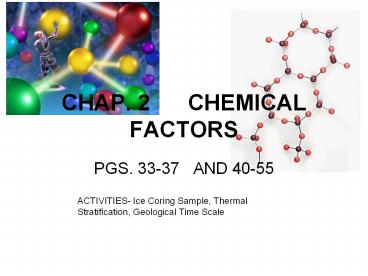CHAP. 2 CHEMICAL FACTORS - PowerPoint PPT Presentation
1 / 28
Title:
CHAP. 2 CHEMICAL FACTORS
Description:
CHAP. 2 CHEMICAL FACTORS PGS. 33-37 AND 40-55 ACTIVITIES- Ice Coring Sample, Thermal Stratification, Geological Time Scale * I. PROPERTIES OF WATER A. hydrogen ... – PowerPoint PPT presentation
Number of Views:115
Avg rating:3.0/5.0
Title: CHAP. 2 CHEMICAL FACTORS
1
CHAP. 2 CHEMICAL FACTORS
- PGS. 33-37 AND 40-55
ACTIVITIES- Ice Coring Sample, Thermal
Stratification, Geological Time Scale
2
I. PROPERTIES OF WATER
- A. hydrogen bonds- holds molecules together with
weak chemical bridges - polar molecule
- high heat capacity
- viscosity thickness
- surface tension
3
(No Transcript)
4
B. density- mass/vol. provides buoyancy
- expansion of water at 0ºC
- temperature influences density
5
Bond width expands
6
II. COMPOSITION OF SEA WATER
- dissolved inorganic particles (salts)
- dissolved organic (nutrients)
7
- dissolved gases
- suspended particles
8
A. salts NaCl
- Principle of Constant Proportion
- (see handout)
- ions per 1000 g of water
- Cl, Na, S, Ca, K 99
- 86
- salinity 1.8050 x chlorinity
9
B. Dissolved gases
- O2, CO2 ,N2
- fig. 2-7 in text
10
B. Dissolved gases
- O2, CO2 ,N2
- fig. 2-7 in text
- Gas is more soluble in cold water
- O2 enters from the atmosphere and photosynthesis
- Anaerobic without oxygen
11
III. THERMAL STRATIFICATION
- water layered by temperature- 250 C to 40C
- Thermocline - narrow region of rapid temperature
change
12
Spring Turn over SUMMER
13
Spring Turn over FALL
14
Spring Turn over WINTER
15
Spring Turn over SPRING
16
- Nutrients are brought up from the bottom
- Oxygen is carried down to aid in aerobic
respiration
17
IV. LIGHT ABSORPTION
- 65 of light is absorbed in the first meter
"heats water" - colors are selectively absorbed
- absorption depends on suspended particles in the
water
18
Why is the ocean BLUE?
- colors are selectively absorbed by the water
molecules
- RED LIGHT penetrates the least
- Blue light penetrates the furthest
19
-
- absorption depends on suspended particles in the
water - Reflection of light occurs too!
- Each area has its own absorption and reflection
profile - estuaries,
- open ocean
- continental shelf
20
V. BUFFERING
- the ability of a liquid to resist pH change with
the addition of acid - pH scale 1-14 log scale
- sea water typically 7.5-8.4
- CO2 is the main influencing agent on pH
- Large amounts of CO2 can be stored in sea water
because it is converted into other compounds
21
(No Transcript)
22
Test Topics for Thursday
- Ocean chemistry
- Properties of water (polarity, density changes,
viscosity, shape of molecule, etc) - Distribution of components
- -be able to draw graphs (light, temp, oxygen)
- Geological time scale (Era names and dates)
- important marine events
- Be able to explain the results from lab
activities- density and temperature driven
currents - Chap 2 text PGS. 33-37 AND 40-55
23
Geological Time Scale
24
Nonconformity in the Grand Canyon - Sediments
deposited over Schist
JUST ADMIRE THE PICTURE
25
Names are given to times in the past that have
been marked by a significant change in the
fossil and rock record
26
Correlation of rock layers
- Matching strata of similar ages in different
regions is called correlation
http//www.uwsp.edu/geo/faculty/ozsvath/images/str
atigraphy.jpg
27
Geologic Timescale
Homework Learn Timescale.doc less Epochs
Divisions based on fossils Eon, Era, Period, Epoch
28
Origin of Period Names































